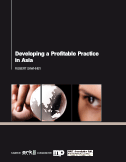
|
http://www.patrickmckenna.com/blog
Page << Prev 40 41 42 43 44 45 46 47 48 49 Next >> of 95
Post #510 – Tuesday, December 7, 2010
Firing On All Cylinders
 I just completed my latest one-day master class (Firing On All Cylinders) this past Wednesday for practice group leaders; this one held at The American Management Center in New York. Sponsored by Ark Conferences, this was the eighth consecutive workshop that I’ve had the honor of conducting. I just completed my latest one-day master class (Firing On All Cylinders) this past Wednesday for practice group leaders; this one held at The American Management Center in New York. Sponsored by Ark Conferences, this was the eighth consecutive workshop that I’ve had the honor of conducting.
Looking back, I see that I have now had the priviledge of training practice group leaders from over 60 law firms throughout the United States, often with multiple participants coming from the same firms. Amongst that group, I’m particularly pleased to have worked with practice leaders coming from 17 of the AmLaw 100 largest firms; including Greenberg Traurig, Kirkland & Ellis, Morgan Lewis, Sidley Austin, Weil Gotshal and Winston & Strawn.
Thank you all for allowing me to be of service.
Post # 509 – Friday, November 26, 2010
Where Leaders Stumble
 I’m currently collaborating with a colleague who is doing a lengthy research project attempting to identify the characteristics, traits and behaviors of the most effective law firm managing partners. In our most recent discussions he posed this question: “In firms you've observed where the managing partner isn't doing well or leadership is weak or dysfunctional, what one or two things do you find are the biggest or most common causes of failure?” I’m currently collaborating with a colleague who is doing a lengthy research project attempting to identify the characteristics, traits and behaviors of the most effective law firm managing partners. In our most recent discussions he posed this question: “In firms you've observed where the managing partner isn't doing well or leadership is weak or dysfunctional, what one or two things do you find are the biggest or most common causes of failure?”
To provide a meaningful response, I went back through a decade worth of notes from training practice group leaders, scrutinized the results from the psychometric data that I have had over 50 new managing partners complete as part of the First 100 Days Program, and reflected upon what I’d observed in working with hundreds of law firms over a couple of decades. Here are some of the more common warning signs that I’ve observed in working with leaders at all levels:
• Displaying Arrogance
These are those leaders who just naturally expect to be admired, praised, indulged, and obeyed. They anticipate that they will be successful in everything they do, believe in their own legacy, and when their expectations are frustrated, they explode with "narcissistic rage." From my observer’s perspective, what is most distinctive about these leaders is their self-assurance which often gives them a certain presence—they are the first to speak in a group, and they do so with great confidence . . . even when they are wrong.
If you think you have all the answers and that your role as leader is basically to direct your peers as to what each should be doing; to assign each a specific project and dictate who will work on which, you may just be in for some critical push back. This leader stumbles whenever they begin to think that their colleagues need to serve them, as apposed to the leader serving his/her people. You need always to be willing to work along-side your people to get the job done. In other words there should be nothing in your practice group or firm that anyone else does, that you would not be willing to do yourself.
The very best leaders recognize that their role is to help those in their groups/firm, become even more successful in their careers than they would have had that leader not been in the picture.
• Suffering A Lack of Focus
This lack of focus can occur in several ways. Oftentimes, the leader unconsciously allows the urgent to crowd out the important and then eventually loses sight of what they are trying to accomplish that will advance the firm. Even more debilitating, the leader ends up trying to do too much or too many things at the same time, appearing to start one project, quickly losing interest, and then gravitating to the next ‘flavor-of-the-month.’
Suffering a lack of focus then disorients a leader and sets the stage for poor communication. These leaders delude themselves into believing that their colleagues can sense their goals and carry out their wishes without being told. When misunderstandings arise, they blame others for a lack of effort (or commitment) rather than recognizing their own negligence.
At the present moment, what is your primary focus? If you can't write it in a couple of short, pithy paragraphs, then your leadership suffers from a lack of clarity. Take the requisite time to center your focus on what's most important.
• Putting Paper Before People
Often leaders become so task orientated, that they forget to be people orientated. As a leader you can quickly become so consumed by the day-to-day requirements that all too often you make the mistake of seeing your partners more as interruptions than opportunities. As a leader your colleagues will always be seeking your attention, and that’s what you’ve got to give them.
Leadership is basically a people business. You can’t let paperwork and deadlines create a barrier between you and the opportunity to touch your colleague’s lives. So here’s the key: Never see your people as interruptions, because those kind of interruptions is your work. If your partners conclude that your day-to-day tasks are more important, they come to the conclusion that you don’t care about them. And there is a very old cliché that no leader should ever lose sight of . . . ‘People will never care how much you know, until they know how much you care.’
• Being Risk Adverse
The overly cautious leader is careful, conservative, and worried about making mistakes. Even positive feedback can be distorted or discounted. These individuals cannot seem to tolerate the unpleasant feelings associated with making a mistake; and as a result, they seek to avoid the unpredictable events related to decision-making. At their best, they are prudent and careful about evaluating risk; they rarely make rash or ill-advised moves, and they provide sound advice about intended courses of action. At their worst, however, they avoid innovation, resist change, stall, and drag their feet, even when it is apparent that something needs to be done.
These kinds of leaders fear failure far more than they desire success. Past success creates pressure: "Will I be able to sustain my past practicing performance in this new role?" When driven by the fear of failure, these leaders are unable to take reasonable risks. They limit themselves to tried and proven pathways. Any thoughts of trying to be innovative diminish and eventually disappear.
No progress has ever been made without new ideas being accepted and implemented. Leaders need to continually ask themselves: “Which is more important, the journey or the destination?” Are you still taking reasonable risks? Prudent leadership avoids reckless risk, but neither is it paralyzed by fear.
Poor leadership in good times can be hidden, but poor leadership in bad times is a recipe for disaster. The warning signs in life — from speed limits to prescription labels — are intended to protect us from disaster. As you consider these warnings of leadership failure, don't neglect taking an honest look at your situation.
The above represents my latest column for Slaw. Slaw identifies itself as “a cooperative weblog on all things legal.” Slaw has been publishing for five years and gets 30,000 unique visitors and about 100,000 visits every month. For the past two consecutive years it has been the winner of three different awards as the best legal blog. I’m honored to have been asked to become a regular columnist and invite you to comment on my latest meandering.
Post #508 – Wednesday, November 24, 2010
Developing a Profitable Practice in Asia
Given the relative slowdown in the European and North American legal markets; and the projected continuance of soft market conditions, the Asian legal market is increasingly taking on a more important role in the fortunes of western law firms. In Hong Kong alone, for example, the number of foreign law firms has doubled in the last few years as the city solidifies its position as a financial centre and a potential source of funds for the growing number of mainland Chinese companies expanding their businesses internationally. That said, without a clear strategy in place that reflects the unique cultural considerations of these regions, any expected rewards will not be achieved. And, there is only one guy in ALL of Asia who really knows the terrain and can guide you through . . .
 My good friend and strategic alliance partner, Robert Sawhney has just released his newest book entitled, Developing a Profitable Practice in Asia. Robert is the managing director and senior partner at SRC Associates Ltd, a Hong Kong based consulting firm that works throughout Asia with law and other professional service firms on their key strategy, marketing, internationalization and competitiveness issues. He has consulted for some of the leading professional service firms in places such as Hong Kong, Singapore, India, Vietnam and China. In addition to his consulting work Robert has written numerous articles for pre-eminent publications such as the Business Times (Singapore), Hong Kong Lawyer, Hong Kong Accountant, Managing Partner magazine (UK), Singapore Law Gazette, Law Dragon (US), Australian Law Management Journal, the Lawyer (UK), Hong Kong Economic Times and the ACCA Journal among many others. My good friend and strategic alliance partner, Robert Sawhney has just released his newest book entitled, Developing a Profitable Practice in Asia. Robert is the managing director and senior partner at SRC Associates Ltd, a Hong Kong based consulting firm that works throughout Asia with law and other professional service firms on their key strategy, marketing, internationalization and competitiveness issues. He has consulted for some of the leading professional service firms in places such as Hong Kong, Singapore, India, Vietnam and China. In addition to his consulting work Robert has written numerous articles for pre-eminent publications such as the Business Times (Singapore), Hong Kong Lawyer, Hong Kong Accountant, Managing Partner magazine (UK), Singapore Law Gazette, Law Dragon (US), Australian Law Management Journal, the Lawyer (UK), Hong Kong Economic Times and the ACCA Journal among many others.
 This text is packed with key case studies, crucial information and guidance, and will enable you to: This text is packed with key case studies, crucial information and guidance, and will enable you to:
• Gain an understanding of the key legal markets in Asia (Vietnam, China, Japan, South Korea, Hong Kong, Singapore, Indonesia, Malaysia, India, Thailand, Taiwan);
• Identify the key players, investment trends and issues within these dynamic regions;
• Re-examine and strengthen your market-entry strategies;
• Navigate and forge successful strategic relationships;
• Understand the key factors that shape the competitive context of Asian legal markets;
• Enhance your firm’s own competitiveness, sustainability and value; and
• Optimize your firm’s Asian presence by implementing a ‘customized’ approach.
You can access more information about Bob’s new book – here. I sincerely recommend that if you have any interest in the Asian markets, that you get a copy of this text to serve as your guidebook; and then get ahold of Bob to serve as your guide.
Post #507 – Tuesday, November 23, 2010
What The Next Generation Law Firm Might Look Like
A number of journalists and sages have been contemplating what the next generation of law firm might look like . . .
 Imagine This Scenario: You begin your work day with a short (20 yard) commute to your home office. As you get comfortable at your desk, you enter through the secure web portal, and your digital workspace unfolds before you. The presence and availability of your colleagues is indicated to you, as yours is to them. You may begin your workday with a scan of your customized news feed for updates on your clients, practice areas, and colleagues. You follow this up by checking the real-time status of your active matters and inviting team members for a strategy session via an online video chat. Imagine This Scenario: You begin your work day with a short (20 yard) commute to your home office. As you get comfortable at your desk, you enter through the secure web portal, and your digital workspace unfolds before you. The presence and availability of your colleagues is indicated to you, as yours is to them. You may begin your workday with a scan of your customized news feed for updates on your clients, practice areas, and colleagues. You follow this up by checking the real-time status of your active matters and inviting team members for a strategy session via an online video chat.
Your home office is fully supported by hub offices that provide comprehensive administrative and operational support. Such support includes full time reception and call routing services, mail service, and large scale copying and document preparation. Your fellow attorneys can access a variety of other administrative links from the portal. They can order office supplies and access external reference and research sites.
During the course of your workday client data, research, prior work product, and matter management tools are literally at your fingertips. Detailed profiles of each attorney’s experience, prior work history, current matters, team members with whom you have worked, education, publications, client successes, bar admissions and language abilities are searchable at any time. A “workload” gauge gives you and your colleagues appropriate information regarding any attorney’s availability and suitability for a particular assignment. The gauge includes factors that might play a role in the assignment, including the time zone in which the attorney lives, or whether they are full-time or part-time. Your fellow attorneys frame their work/life style electronically, through detailed use of calendars, so that their presence and availability is easily accessible to others.
By the end of the day, you have assembled research and knowledge assets from the database systems, updated documents, and facilitated an online client meeting with screen-sharing. Before logging out, you post a question to another practice group, update your workload status, and “walk” down the virtual hallway interface to tap one of your colleagues for advice on a new client matter. Your workday ended early today, due to a scheduled personal engagement, and you have set an alert to automatically send you a text message if the status of your active matters changes or a client message is received.
Your law firm charges clients much less than any other AmLaw 200 firm—probably about 50% less. This cost reduction is supported by the elimination of the partner profit model and all non-productive overhead. Additional major efficiencies come from some of the most advanced process engineering, information technology and Knowledge Management systems that have ever been applied to legal practice. The lawyers working with you on your client matters are senior-level attorneys drawn primarily from the ranks of the AmLaw 200 and from in-house legal departments of leading corporations. They are rewarded for their efficiency and client satisfaction, not according to a high billable hour quota. All of this results in a higher level of excellence at a much lower cost – a cost that has been budgeted with the client in advance.
This information has been drawn from documents that appear on the website of a different kind of law firm – www.clearspire.com Rather fascinating! Have a look for yourself at what your new competition might NOW look like.
COMMENT RECEIVED:
As opposed to a very good picture of what the present generation of law firm looks like - http://www.anonymouslawfirm.com. The lawyer profiles are excellent.
JLT, Partner, large regional firm.
Post #506 – Monday, November 15, 2010
What Future Law Firm Leaders Will Need
 The next generation of law firm leaders will need both business and people skills, as well as a thick skin, according to a survey of those currently in the job. The next generation of law firm leaders will need both business and people skills, as well as a thick skin, according to a survey of those currently in the job.
Ninety-two leaders of law firms with more than 100 lawyers responded to the survey (PDF) by law firm consultant Patrick McKenna, who teaches an annual class for new managing partners at the University of Chicago.
McKenna asked the respondents what skills and attributes are most needed for the next generation of law firm leaders. Some saw no difference in the skills needed by future and today’s leaders. Other popular answers predicted future leaders will need:
• Financial and business acumen, as well as strategic thinking skills, to handle increased competition and more rapid commoditization of legal services.
• Capacity to build consensus and bring about change, and to deliver tough love with compassion.
• Good interpersonal and communications skills.
• Courage, patience, a sense of humor, and “a thick skin to the point of having all nerve endings removed.”
• Serious dedication to the success of others.
McKenna tells the ABA Journal that the ability to oversee change is becoming more important in an era of outsourcing, alternative fees and virtual law firms. Those who see no difference in the characteristics needed now and in the future may be in a geographic area where legal fees are low and revenues are up, he says.
Or they may be “sadly delusional in hoping that their world will eventually return to normal,” he writes in an e-mail.
This Post was authored by Debra Cassens Weiss and appears on today's ABA Journal Law News Now
Post #505 – Monday, November 15, 2010
A Growing Industry Niche
I, frankly, wasn’t quite sure whether he really wanted to work or to play! When my son, David, was first recruited by an international video game development studio, all of my dreams of his one day working alongside Steven Spielberg were shattered. He rejected the film industry for what . . . video games? Well, that was some years back, and today he leads development projects, recruits notable actor and actresses to provide voice-overs (traveling back-and-forth between LA and Vancouver), and has engineered the sound on award-winning games (Best Developer, IGN.com Best of 2006 Awards).
I mention that because somewhere in the last decade video game releases surpasses box office film releases to announce that video gaming has now become a major industry niche. By way of example, in this past week, one new game sold 5.6 million copies (US $360 million in revenues) in the first 24-hours after its release.
Industry observer Scott Steinberg claims, “I think it is fair to say at this point that video games have not only equaled but surpassed Hollywood in many ways. Games have started not only to exceed what we would expect from blockbuster entertainment experiences but completely knock them out of the water.”
Apparently the video game industry has been growing by about 10% year over year (in spite of the economic slowdown) and is now a $10 Billion a year business – quite similar to movie box office revenues. At the same time, modern gaming technology is making the development process nearly as expensive as making a film. “US$30-million to US$40-million is not unheard of [in game production],” Steinberg tells us. He points to the example of Grand Theft Auto 4, which developer, Rockstar North Ltd., had to hire more than 1,000 people to build over 3 years, at a cost exceeding US$100-million.
Meanwhile, business has never been better for (those few) lawyers doing video-game law, in any of its varied manifestations. Lawyers working in the video-game industry occupy a variety of roles and perform a variety of tasks, ranging from IP work to First Amendment litigation. These lawyers describe the video-game industry as being similar to the music and movie businesses in that like record labels and movie studios, developers finance projects they believe have a chance of success.
Post #504 – Wednesday, November 10, 2010
Lack of Interest In Change?
I was reading a piece the other day wherein the author lamented that lawyers have a lack of interest in change. While I won’t take issue with the validity of that statement, I do find it fascinating how we continue to subscribe to a model for leading change that simply doesn’t work.
What model? Well it goes something like this . . .
 We begin by (unconsciously) trying to overwhelm our partners with data – facts, statistics, figures, flowcharts in amongst our rousing speeches to let them know why we must, as a successful firm, adapt to new market changes. We like to think that the facts (as we perceive them) will convince our partners to change – that our colleagues are essentially rational if given accurate information. We believe that if we provide relevant data about the issue, make a sound business case for what needs to be done and present our recommendations, our colleagues will act quickly and forcefully. We begin by (unconsciously) trying to overwhelm our partners with data – facts, statistics, figures, flowcharts in amongst our rousing speeches to let them know why we must, as a successful firm, adapt to new market changes. We like to think that the facts (as we perceive them) will convince our partners to change – that our colleagues are essentially rational if given accurate information. We believe that if we provide relevant data about the issue, make a sound business case for what needs to be done and present our recommendations, our colleagues will act quickly and forcefully.
If partners have doubts or disagree (and you can be assured that they will), we take that as a clear sign that we haven’t yet done a good job of presenting the evidence. So, when partners don’t immediately get on-board with any suggested course of action, we push the idea. We try harder to persuade them. We try to give them stronger data. We keep doing the same thing only more of it. And, we TURN UP the volume. We explain it over and over again. (After all, the communications consultants tell us that you can never over-communicate your message!)
In escalating our efforts, we take more and more ownership of the problem. To get people on-board, we are told that we need to “create a burning platform” – a sense of urgency, so that our partners will take the need to change seriously. We therefore, present our facts with an emphasis on the dire consequences for our partners in not doing what we want them to do.
“If we don’t develop project management skills, we are definitely going to lose clients . . . we may even go out of business”
While fear may occasionally serve as a short-term motivator, at an emotional level, urgency and fear are close cousins. Our partners may react to our fervor by becoming even more resistant. They rarely (if ever) respond with appreciation for our tenacity. Instead, we find that a number of them are either getting angry or simply tuning out whenever we talk. As we continue to push, partner resistance increases in direct proportion to our actions.
The problem is that this commonly-used approach seldom works. If you think about it, it is build upon the assumption that you are right and those of your partners who “don’t see the light” are wrong. Unfortunately, this approach all too often turns the exchange into a contest over whose idea or beliefs will win.
COMMENT RECEIVED:
 Oh so right Patrick. From the perspective of one who has done so for so long, repeatedly hitting one's head against stout walls fortified by resolute defense of the status quo is at best masochistic and more likely downright insane. Perhaps the answer is leadership by leaving -- by building the new delivery systems and exploiting the disruptive technologies others only talk about without regard to the detractors. Simply disengage from the mainstream and create your own path. In other words, leadership by deed and action as opposed to advocacy and white paper. Oh so right Patrick. From the perspective of one who has done so for so long, repeatedly hitting one's head against stout walls fortified by resolute defense of the status quo is at best masochistic and more likely downright insane. Perhaps the answer is leadership by leaving -- by building the new delivery systems and exploiting the disruptive technologies others only talk about without regard to the detractors. Simply disengage from the mainstream and create your own path. In other words, leadership by deed and action as opposed to advocacy and white paper.
Such leaders, while few in number, are Increasing in diversity. Just to name a few, take a look at Valorem, PLC, Summit, Seyfarth, Eversheds, Legal Zoom, Cisco, Wolverine, and many others and the seeds of innovation and creative disequilibrium are apparent and widespread. Firms, LPO's, in-house groups and fellow travelers are seeking out bold new models and platforms. In many respects, they are neither coordinated in their approach nor in agreement on their direction. Will all prosper and prevail while all of the status quo withers and dies? Of course not -- but that's the beautiful thing about change. It's messy, inconsistent, and uneven -- and while inevitable, it often goes unrecognized by those in its midst before what could be a trend becomes the new normal.
So I have two pieces of advice to all of you: first, go read "Oh The Places You'll Go" by Dr. Seuss -- the wonderfully inspirational adult self-help manual masquerading as a children's book; and second, don't worry about leading and focus instead on going.
Jeffrey Carr, General Counsel, FMC Technologies Inc.
Post #503 – Tuesday, November 9, 2010
On Titles, Designations and Job Descriptions
Nowhere, would it seem, are we quite as creative in the profession, as when it comes time to choose a designation for that individual who serves as our firm leader. Thus far, my colleague Brian Burke and I have tracked some fourteen (plus) different titles:
 Firm Chair, Firm Chair,
Executive Chair,
CEO,
President,
Managing Partner,
Managing Director,
Managing Shareholder,
Managing Officer,
Managing Member,
Chief Executive Partner,
Executive Partner,
Presiding Partner,
Presiding Member,
Administrative Partner,
And of course you get to repeat it all if there is more than one professional sharing the responsibility . . . co-Managing Partner, etc.
Have we missed any??? This has gotten to be such fun that we’re eager to learn of any firm who has developed a title that’s not listed here.
Meanwhile, in my newest survey (just completed), I asked a dozen questions of firm leaders and received responses from 92 of those individuals who lead firms of at least 100 attorneys. (I then compared those results against a similar study that I conducted back in July 2004). I can now report that, irregardless of the title, 72% of law firm leaders responded that they are operating without a formal, written job description. And, many of those who claimed to have a job description were quick to point out that the description was “rather broad” or really “just a part of the firm’s partnership agreement.” This percentage is almost identical to the results I found in 2004 and is consistent among firms of all sizes.
One might wonder if this question is suggestive of inviting a degree of bureaucracy. From my vantage point, I recall an assignment some years back with a 350+ lawyer firm going through the process of selecting a new Managing Director. Upon learning that there were likely going to be over a half dozen candidates interested in the position, we set about creating the first job description. From an activity-based analysis, we were able to identify some 72 different and important activity bullet-points that represented what the current firm leader actively had responsibility for executing. Our subsequent presentation of the formal job description had a number of the candidates withdrawing their interest.
I have since confirmed (repeatedly) that many partners, in many law firms, haven’t the foggiest idea of the enormity of the firm leader’s job.
I guess firms will have to make this their next focus of creative thought.

COMMENT RECEIVED:
John Moore at Thynne & Macartney in Brisbane Australia has as his official title, Chairman of Partners. He says, "Within the firm it is not a title I need to use because everyone knows the role I play in that respect. I use the title when executing documents on behalf of the firm."
Post #502 – Thursday, November 4, 2010
Turning Away From Your Values
Deeper and deeper into trouble . . . the US government runs $3 trillion of deficits since the end of '08. The Fed now prepares to print $600 billion more, on top of the $1.7 billion it printed a year ago.
 Are we watching a once great nation slowly disintegrate? Are we watching a once great nation slowly disintegrate?
The Private Sector Survey on Cost Control, commonly referred to as The Grace Commission, was an investigation requested by US President Reagan, in 1982. The focus of it was waste and inefficiency in the Federal government. Its head, businessman J. Peter Grace, asked the members of that commission to "be bold" and "work like tireless bloodhounds. Do not leave any stone unturned in your search to root out inefficiency.”
CAGW, a descendant of Grace's brilliantly executed Commission, has been sponsoring a message about the menace of stimulus spending. This advertisement has a Chinese academic studying the great nations of the world and telling his students about how America collapsed because, in the midst of a recession, it relied on government stimulus spending, big changes in its health care systems, and public intervention in major industries. Take a moment, right now, to watch it . . . the message is SHOCKING!
Although this video is clearly meant to make the viewer shudder at the idea of foreign-domination, it uses the threat as a stimulant for us to do better. As a work of persuasion and motivation, I think this will be
remembered by everyone who watches it, as a notably effective
introduction to an important message. The stated argument, even from the Chinese professor, is that America erred by turning away from its own cherished values.
Post # 501 – Saturday, October 30, 2010
If You Can’t Become More Efficient . . .
 Than, it would seem that the best strategic move might be to encourage your competitors to look less efficient. Than, it would seem that the best strategic move might be to encourage your competitors to look less efficient.
An interesting development shared with me this week by an AmLaw 200 client firm: Apparently they were responding to an RFP from a Fortune 100 company. While coordinating their response with a small group of other law firms, the New York-based player requested that when they submit their proposal that they INCREASE the total amount they expected to bill on the matter by more than $3 million. The justification for this request was that "this amount would then be more in line with the other proposals."
My client found this puzzling at first, but upon reflection concludes that the only explanation for this was a huge concern about non-New York firms competing with them on price. My client’s estimated fees for this significant legal matter contemplated no reduction from their regular rates and yet still provided a 40% discount from what the other firms were charging . . . after having reduced their rates.
Page << Prev 40 41 42 43 44 45 46 47 48 49 Next >> of 95
|
|


 Ashridge House
Ashridge House  11226 - 60 Street
11226 - 60 Street  Edmonton, Canada
Edmonton, Canada  T5W 3Y8
T5W 3Y8